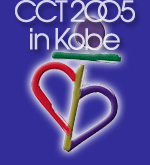 |
The CCT has, since its inception, continued to expand and to make a significant contribution to the expansion of clinical indications and therapeutic strategies for ischemic heart disease and for peripheral vascular disease. In the history of treatment strategies for ischemic heart disease, the arrival
of DES has had perhaps the single greatest impact on the clinical practice of
PCI. There remain, however, a number of unresolved questions even in this era of standardized PCI strategy. These include PCI for chronic total occlusions and strategies for bifurcations and vulnerable plaques. In this context, the CCT will continue to seek innovative answers to these unresolved challenges. Falling in the middle of the first decade of the 21st Century, the focus
of CCT2005 springs from Asia to the wider world. CCT2005 will be characterized
by several new features: Firstly, the official language of the meeting will from
now on be English. | |
CCT Secretariat 1-15-25, Maedaminami-machi, Toyohashi, Aichi 440-0851, JAPAN Tel +81-532-57-1275 / Fax +81-532-52-2883 / E-mail secretariat@cct.gr.jp |